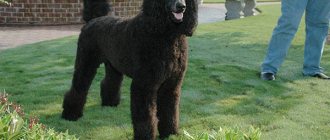Compact size, lush fur, charming face - all this makes the Pomeranian incredibly popular. This miniature dog can be found quite often on the street and in many city apartments. How many years do Spitz, Pomeranian and medium-sized Spitz live? This question worries the owners of these wonderful dogs.
How long do Spitz live?
Decorative dogs are considered long-lived. Typically, Pomeranians live up to 15 years. Of course, provided that they are properly looked after. However, there is an assumption that the lifespan of an orange is directly affected by its size.
| Spitz type | Size | Minimum life expectancy | Maximum lifespan |
| German | 40 cm | From 12 | Up to 15 years |
| Small German | Maximum 28 cm | 12 | 15 |
| Bearish | From 22 to 30 cm | 12 | 15 |
| Pomeranian | 20 cm | 14 | 16 |
In general, Spitz dogs can live quite a long time with good care. However, dwarf varieties cannot boast of this. The lifespan of dwarfs is no more than 7 years. Even the quality of care cannot affect this indicator.
How many years do Spitz live at home?
The lifespan of any dog is directly influenced by the quality of care it receives. Spitz are no exception. The breed is in good health. If you properly care for your pet, it can live quite a long time. Among the Spitz there are even long-livers, whose age is about 20 years.
German
The dogs reach from 20 to 55 cm at the withers, depending on the variety. Their life expectancy is no more than 15 years.
Small German Spitz
The size of these pets can be no more than 28 cm. Their weight, according to the breed standard, is from three to six kg. The dogs are distinguished by their good health and, with good care, live for about 15 years.
Small German Spitz
Medium-sized German Spitz
These pets are also in good health. The dog has an average life expectancy of no more than 16 years. If you take good care of her, she can live even longer and live up to 20 years. This is a very long time for a dog!
Pomeranians
Differ in miniature sizes. The breed standard requires that the dog's height does not exceed 20 cm at the withers. If the pet does not have serious illnesses, then it has every chance of living even 18 years.
Pomeranian Spitz
Bear type
The dogs are miniature in size. Their height does not exceed 30 cm at the withers. Their average lifespan is 12 to 15 years.
Bear-type Pomeranian
Fox type
Females do not grow higher than 21 cm at the withers. Males cannot be taller than 22 cm. They differ in body weight, which does not exceed a maximum of 3.5 cm. However, the standard prescribes an optimal weight of no more than 3.1 kg. They live up to 15 years.
Fox type Pomeranian
Toy type
According to the standard, representatives of this variety of Spitz should not be taller than 22 cm at the withers. Their weight category is no more than 3 kg depending on gender. Males are somewhat heavier.
Pomeranian toy type
The average lifespan of “toys” is no more than 15 years.
Dwarf (miniature) type
The height of a male dog at the withers is no more than 22 cm. Sometimes there are dogs that grow up to 25 cm. The weight category is allowed from 1.3 cm to 3.2 kg.
With good care and no health problems, the pet can live up to 16 years.
Pomeranian dwarf type
Video
https://www.youtube.com/embed/
* We invite you to watch a video about the Pomeranian Spitz breed. In fact, in front of you is a playlist in which you can select and watch any of 20 videos about a given dog breed by simply clicking on the button in the upper right corner of the window. In addition, the material contains quite a lot of photos. By looking at them you can find out what a Pomeranian Spitz looks like.
| In this article: |
This breed has been at the peak of fashion for several years now. This is quite understandable, because with her doll-like appearance she is able to conquer anyone. Pomeranians are more suitable for girls. A cheerful dog will become an excellent companion, and will never refuse to play and run around
But in order for the dog to please the owner for as long as possible, it is first important to learn about the features of its maintenance and the secrets of acquiring it.
| Material content: |
Average life expectancy of a Pomeranian
So, Pomeranians are considered long-lived among dogs. Some of them even live up to 15 years. Their minimum lifespan is 12 years. If the pet has received high-quality and proper care, then it will be able to delight its owners with its presence even longer and live up to 20 years. But care is not the only criterion; the size of the dog also affects its lifespan. Dwarfs live the shortest. No longer than 7 years.
Diseases of the Pomeranian Spitz
Pomeranians are predisposed to a number of diseases:
- Metabolic disease. One of the deviations is hypoglycemia. To eliminate it, you need to feed your pet often and in small portions.
- Eye diseases. Anatomical predisposition to tearfulness, lens opacities, eyelid pathologies, risk of eye injuries, pathology associated with retinal dystrophy.
- Congenital displacement of the kneecap. This pathology is genetic. Trauma can trigger the progression of the disease.
- Black skin. Baldness or partial hair loss often develops.
Genetic disorders
Spitz breeding has been going on for over 100 years. In this case, serious mistakes are often made. Such errors lead to the appearance of various genetic errors that affect the pet’s lifespan.
Among the hereditary pathologies in dwarf Spitz dogs, cryptorchidism is often found, and there is also a risk of developing diabetes. Pigmentation disorders in representatives of the breed also have a hereditary nature.
Dogs often have dental problems, such as tartar. Another serious disease is epilepsy, which is transmitted genetically.
Caring for Pomeranians
The rules for caring for almost any dog are the same. This includes a proper diet, regular walking, and maintaining the Spitz’s coat in perfect condition. The Spitz's coat is thick and requires careful and thorough grooming. The dog needs to be brushed regularly. To maintain the beauty of the coat, you need to purchase several special combs. You will need a slicker brush, a brush with bristle teeth, and a massage comb.
Proper nutrition
Proper nutrition for a Spitz can include both natural products and dog food.
If the dog is on a natural diet, then its diet should include the following products:
- Cottage cheese.
- Kefir.
- Curdled milk.
- Meat (turkey, veal, chicken).
- Offal.
- Vegetables and fruits.
- Seafood.
- Low-fat sea fish.
- Porridge (buckwheat, oatmeal, rice).
- Vitamin complexes and supplements with microelements.
If you feed your pet dry food, you should choose premium or super premium products for decorative breeds.
Considered one of the best:
- Pro Plan dry food, which has many varieties: for puppies, for adult dogs, for aging pets, for dogs with sensitive skin, etc.
- Royal Canin dry food is designed specifically for Pomeranians and also has many varieties: for puppies, for pregnant and lactating bitches, for aging dogs, for pets prone to allergies, etc.
If a dog is on a mixed diet, then 2/3 of its diet should consist of proteins . The rest of the menu consists of cereals, vegetables, fruits, fish and dairy products.
Why do dwarf Spitz live very short lives?
In Spitz dogs of the smallest size, super-dwarfs, developmental disorders of the body are very common. Which leads to their lifespan being very short. The most common cause of death is organ failure. The fact is that the load on the internal organs due to the size of the dog is very high. The body is not always able to cope with it.
The density of a Spitz's coat is not only its decoration. These dogs have an increased tendency to heat stroke. Especially in the summer when it's hot outside. Increased stress leads to heart problems. The older the pet, the higher the likelihood of developing some serious illness. At risk are dogs with very short stature, which is less than 20 cm.
Genetic disorders of dwarf Spitz
Dogs are predisposed to eye diseases, diabetes, and epilepsy.
What can shorten your life?
In addition to the type, the duration is influenced by many negative factors that cause disturbances in the functioning of organs and systems, provoking the development of various diseases. This can shorten your life by 5-6 years.
Among the most common severe types of diseases are:
- disruptions in liver function;
- inflammation of the intestine and neoplasms in it;
- cancerous tumors of various organs;
- inflammation of the pancreas;
- disorders of cerebral circulation and heart function;
- joint diseases.
In addition to diseases, fractures can be the cause of early death, because the bones of this breed are very fragile. Any injury, and especially a fracture, takes away vitality, and with age leads to severe pain, which harms the heart.
Factors that bring death closer are obvious:
- insufficient nutrition and poor diet;
- small amount of physical activity;
- frequent worries, stress;
- refusal of vaccinations;
- no treatment for ticks and fleas;
- lack of attention in the treatment of emerging diseases.
Only by eliminating adverse effects on your dog can you keep it healthy until old age.
How to extend the life of a Spitz
You can significantly extend the life of your pet by following the following care rules. The dog needs a walk. Many owners accustom their dwarf dogs to diapers and litter boxes. However, this only makes things worse for your pet.
How to extend the life of a Spitz
You need to choose the right diet for your dog. When determining serving size, you should strictly focus on weight. If the portions are too large, your dog may become obese. The diet is selected depending on age. The amount of minerals and vitamins depends on this.
In addition, you should try to avoid stressful situations. You are also required to have the required vaccinations.
Proper diet
The Spitz's diet can consist of dry food or natural products. Feed the pet one to three times a day. Sometimes they have snacks. It’s not worth changing your usual diet just like that; it’s a stressful situation for a dog.
Dry food must contain at least 25% protein. The main part of the diet can be animal products; you can give the dog fruits and vegetables. The presence of several groups of vitamins A and B is very important.
Walking and playing with the Spitz
Regular walks in the fresh air are a must for your Spitz. However, before moving to walking, you need to get all the required vaccinations. Before vaccinations, the dog is carried in your arms. I start training him for walking with short walks that last no longer than half an hour twice a day. In the morning and in the evening. Gradually, the duration of walks gradually increases.
Timely treatment and deworming
Your pet's health should be monitored very carefully. This is a tiny dog, and therefore even a minor illness can lead to serious problems. Therefore, at the first ailment, even if it is not serious at first glance, you should contact a veterinary clinic. In addition to vaccinations, dogs are regularly dewormed. For this purpose, special preparations are used. The dosage is selected strictly by weight. The instructions are included with the medicine.
Spitz care and hygiene
It should be remembered that Spitz dogs are very attached to their owners. Therefore, it is worth finding time to communicate with your pet. Spitz are very worried when little attention is paid to them.
The dog needs to be taught to brush itself. As a rule, the pet requires this procedure once or twice a week. Most often, the dog is brushed during shedding. To keep teeth clean, from an early age the dog is taught to brush its teeth.
Spitz care and hygiene
Ears are cleaned and nails trimmed monthly. Keeping the coat clean requires regular bathing every month. To do this, choose suitable cosmetics.
Every six months the thick fur is trimmed. Especially in the area of the ears, paws, and genitals. This haircut will maintain the health of the external organs and give the dog a neat appearance.
Mandatory vaccination
Many infectious diseases pose a mortal danger to Spitz dogs. The first vaccinations are given in puppyhood. Until the puppy reaches three months of age. Then revaccination is done, after which vaccinations are given every year.
The greatest danger to dogs is distemper, enteritis, and a number of other diseases. Mandatory vaccinations include rabies.
Signs of aging
Dog handlers consider Pomeranians to be puppies until their skeletal development is complete. In most cases this occurs by 7-8 months. From this age until 3-4 years, representatives of the breed are at the stage of adolescence. A dog 4 years old and older is already classified as a mature dog.
Typically, from this age, Pomeranians show the main signs of aging:
- various congenital diseases appear;
- the dog becomes susceptible to newly emerging diseases;
- gradual wear of teeth occurs;
- the fur begins to fall out and lose its shine;
- the eyes become a little sunken.
The owner of a Pomeranian Spitz needs to clearly understand that the life expectancy of representatives of this breed directly depends on how the owner takes care of his pet.
Typically, these tiny dogs live longer with owners who provide them not only with love and attention, but also with proper care, timely treatment, regular walks and active games.
Features of keeping a Spitz
Before buying a Spitz puppy, you should prepare the necessary “dowry” in advance.
- You will need bowls for food and water;
- To make the dog feel comfortable, it will need a bed;
- For care you will need towels; for the first time, while the puppy is still very small, stock up on diapers.
To prevent your pet from catching a cold, choose a place where there are no central heating radiators nearby. But at the same time, it is important that the dog does not lie in drafts, since there is a risk of catching a cold. A Spitz does not need a feather bed; a bed that is too soft is contraindicated for it.
To care for the coat, you will need a set of combs.
Breeding German Spitz
The German Spitz breed was bred as a domestic and family dog. Spitz is used to being with people, and this leads to his good attitude towards them. They are usually very well educated due to their obedience. The reproductive cycle of a female German Spitz is 60-64 days. The first period, called proestrus, lasts about 9 days. At this time, females begin to attract males. Swelling of the vulva and bloody discharge may be noticed. The second stage is estrus, when the female is receptive to the male. Estrus lasts from 3 to 11 days.
A sign of estrus is a soft and enlarged vulva. The third period is diestrus. It usually lasts about 14 days. During this period, the vulva returns to average size and no longer allows mating. The fourth period is called anestrus. The time between German Spitz breedings usually lasts about six months. The German Spitz litter size is 2-4 puppies.
In the German Spitz, reproduction can occur once a year. More frequent reproduction will not be healthy
It is very important not to buy a dog from a puppy mill where the needs of the puppies and their mothers are ignored. This is an inhumane large-scale dog breeding operation where puppies are born several times a year.
Spitz age compared to human years
Many people find it interesting. What might be the age of a four-legged friend if we translate it into human standards. At the same time, you need to understand that time flows differently for pets of different sizes. Dwarf dogs grow faster and mature faster.
| Dog's age | Person's age |
| Year | 13-15 |
| Two years | 21-24 |
| Three years | 23-28 |
| Four years old | 30-33 |
| Five years | 34-36 |
| Six years | 39-40 |
| Seven years | 43-45 |
| Eight years | 46-49 |
| Nine | 50-53 |
| Ten | 54-57 |
| Eleven | 57-60 |
| Twelve | 62-65 |
| Thirteen | 65-67 |
| Fourteen | 69-73 |
| Fifteen | 74-77 |
| Sixteen | 77-81 |
Having a dog is a childhood dream
The first I got was Amur, a cute 4 month old bear puppy. This is a Pomeranian Spitz of a rather rare type - bearish. Cupid is my first dog. And I dreamed of just this for a long, long time. When they gave it to me, I realized: dreams come true! And that was almost eight years ago. Literally immediately we found a common language with him
He was always good: obedient and, importantly, not mischievous. There were no problems at all in terms of getting used to it
But until she was two years old, the dog was sick a lot. Cupid underwent two operations. The first time he had a kneecap inserted. Then he broke his front leg (he jumped off the couch unsuccessfully), and the fracture was displaced, and a special knitting needle was inserted into him. In conclusion, he also caught an infection - they barely saved him. So he suffered with me at a young age, he knows well who veterinarians are.
Now Cupid is an arrogant and lazy dog, but incredibly affectionate and gentle.
In the photo: Spitz Amur. Photo: from the personal archive of Tatyana Lentsevich.
Caring for an Elderly Spitz
Closer to nine years of age, the Spitz gradually enters a period of old age. The dog takes on the features of an older dog. He is less interested in games, he is harmful and can even behave aggressively.
First of all, you need to change the food to one that is suitable for your pet’s age. Carbohydrates and fats in food should be kept to a minimum. Proteins will be much healthier. Dogs' joints age very quickly. Therefore, you need to handle your pet as carefully as possible. Especially during water procedures.
Caring for an Elderly Spitz
You should maintain the condition of his teeth and brush them regularly. Toys that your dog can chew on will be helpful. This will help maintain their health. If necessary, the teeth are periodically examined and cleaned by a veterinarian. Regular treatment is also required.
Character traits
White Pomeranians can look cute and even defenseless. But, in fact, these dogs are characterized by such traits as activity, energy and courage.
They are sociable, positive and sociable, and they also love to run and play.
Spitz are friendly towards other animals and love children as long as they are not too pestered or teased.
IMPORTANT! However, if there is no socialization or training, their character can deteriorate. This is why it is unacceptable to deprive White Pomeranians of physical or mental exercise, especially since these dogs are very smart and love to learn.
Tips for owners
There are a number of tips that those who consider themselves a good owner should pay attention to:
- If there are any changes in your Spitz’s mood or behavior, it is recommended to consult a veterinarian;
- in hot weather, your pet will need a haircut to alleviate its physical condition;
- Vaccinations must be carried out on time;
- Communication with relatives is beneficial for a pet, so it is recommended to spend walks with other animals;
- It is worth noting that castration in boys also prolongs life, protecting animals from the early development of diseases of the genitourinary system.
It is important to understand that you need to constantly monitor the condition of a small dog. This is not just a cute animal, it requires careful care and regular visits to the veterinarian. Compliance with all the rules will extend the life of your beloved furry.
Origin
The name comes from the name of the historical region in Germany - Pomerania. In America and Russia for a long time these Spitz were called differently - miniature Spitz or simply dwarf. This is the smallest representative of the Spitz.
During the reign of Queen Victoria, in 1870, Spitz from Pomerania came to England, where work began on creating a dwarf form, improving the “clothing” of the Pomeranian and giving it overall sophistication. The beauty of the best representatives of English and American Spitz has a great influence on breeders all over the world, and gradually Spitz in other countries are modified, catching up to the standard Pomeranian. The queen herself loved her Spitz Marco so much that she was with him always and everywhere.
Choosing a puppy
When choosing a puppy, you should consider the purpose of the purchase and the desired one. Adult Pomeranians have well-defined sexual dimorphism. Males are more elegant, fluffier and larger than females. But it is worth considering that girls are more attached to the house and owner, more affectionate and obedient.
Signs of a healthy puppy:
- sparkle in the eyes;
- the puppy is active, perky, playful;
- the fur coat is neat, combed and soft to the touch;
- when seeing a stranger, the dog does not show cowardice or aggression;
- no signs of nervousness.
Six month old puppy
History of appearance
Spitz-shaped dogs appeared in Europe, including Germany, back in ancient times. Their ancestors were German turf dogs who lived in the Stone Age.
At the same time, the first Spitz dogs were much larger and more powerful than modern Pomeranians. This is not surprising, because in those days a dog was not just a companion or a fashionable toy, but a friend and assistant helping ancient people survive in a harsh world full of dangers.
White dogs, which became the ancestors of modern Spitz, have long been bred in the German province of Pomerania, from which the breed got its name.
Miniature Spitz-shaped dogs appeared much later - the first information about them was found in November 1764 in the diaries of James Boswell, traveling through Germany and Switzerland.
But three years later, Queen Charlotte, who was the wife of the English King George III, brought two Spitz dogs to Britain.
Thanks to her, the breed in a very short time becomes one of the most popular in England, as evidenced by paintings from the 18th century depicting Spitz dogs. One of the most famous is the portrait of Mr and Mrs Hallett, painted by Thomas Gainsborough.
This painting, dated 1785, shows a pure white dog that bears a striking resemblance to a modern Pomeranian. True, in the 18-19 centuries, dogs of this breed were much larger and weighed 14-23 kg.
With the coming to power of Queen Victoria, who was passionate about cynology, a breeding nursery was founded at court. Moreover, the queen ordered the smallest Spitz dogs to be selected for breeding, as she dreamed of breeding truly miniature dogs. This led to impressive results - during Victoria's reign, the size of the Spitz was halved.
In 1891, the first breed club was founded in England, and soon the first breed standard was written.
NOTE! Two Pomeranians were among the three dogs that escaped from the Titanic, as the owners of these dogs did not want to be separated from their pets even under the threat of death.
In 1998, the Pomeranian was recognized as one of the size varieties of the German Spitz. And, of course, white color, as one of the most ancient and classic, was also indicated there.
Key points in training
Spitz are decorative dogs; they do not need training for hunting or working breeds.
But general training is required. You can seek help from professional dog handlers who will help the owner and puppy establish contact and understand the principles of training. You need to start raising and training your baby from the very first days. Spitzes have a manipulative streak where they feel like they can do anything. It is worth understanding that this is not a plush toy, but a dog that must obey its owners.
Therefore, it is important to prohibit the animal from eating from the table, sleeping on furniture, playing with household items, biting and snapping. You can’t beat your pet, but you can strictly explain it and deprive it of treats.
The socialization course consists of a consistent introduction to the environment. At first, the puppy is taken out to quiet parks. Then to the dog parks. After the baby has become accustomed to the company of other people and animals, you can try taking him for a walk on noisy avenues, train stations, or taking a ride on public transport. This will help your pet learn to control his emotions, stop being afraid of loud sounds, and get used to cars and roads.











